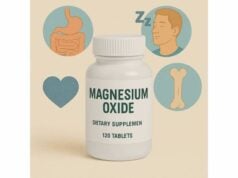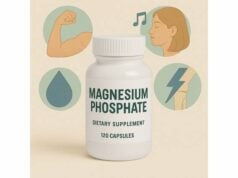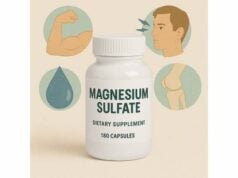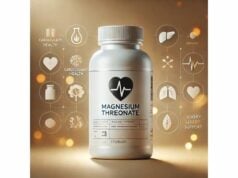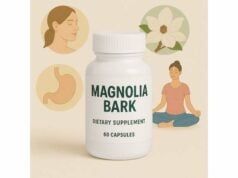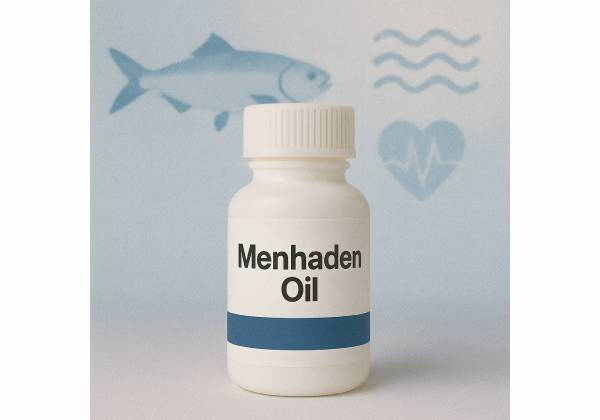
Menhaden oil is a concentrated source of marine omega-3s extracted from Atlantic and Gulf menhaden—small, oily forage fish long used for both nutrition and industry. Like other fish oils, it supplies eicosapentaenoic acid (EPA) and docosahexaenoic acid (DHA), two long-chain omega-3 fatty acids linked to triglyceride lowering, anti-inflammatory actions, and potential cardiovascular benefits in select groups. Because menhaden are low on the food chain and harvested in large schools, their oil tends to be relatively uniform and amenable to purification techniques that remove contaminants. It’s also one of the few fish oils specifically recognized by U.S. regulators for safe use as a food ingredient when formulated to meet purity standards. In this guide, you’ll learn how menhaden oil compares to other omega-3 sources, who may benefit (and who should avoid it), evidence-based dosage ranges, and practical selection tips to buy a high-quality product. The goal is simple: help you decide, with clarity and confidence, whether menhaden oil fits your health goals and how to use it safely if it does.
Essential Insights
- EPA and DHA from menhaden oil can reduce fasting triglycerides, with prescription-strength doses (around 4 g/day) having the most robust effect.
- High daily intakes of marine omega-3s (≥1 g/day) are linked to a small but measurable increase in atrial fibrillation risk in some trials.
- Typical supplement use: 250–1,000 mg/day EPA+DHA for general omega-3 coverage; 2–4 g/day EPA+DHA (or 4 g/day EPA-only by prescription) for high triglycerides.
- Avoid if you have a fish allergy, a history of omega-3–related atrial fibrillation, or you take anticoagulants without medical supervision.
Table of Contents
- What is menhaden oil?
- Does it work for heart health?
- How much menhaden oil per day?
- Who should not take menhaden oil?
- How to choose a quality product
- What does the research actually show?
What is menhaden oil?
Menhaden oil is a fish-derived lipid concentrate pressed and refined from Atlantic (Brevoortia tyrannus) and Gulf (Brevoortia patronus) menhaden. Menhaden are small, schooling, plankton-feeding fish abundant along the U.S. East and Gulf Coasts. Because they feed low on the food chain and grow quickly, menhaden accumulate EPA and DHA while maintaining relatively low levels of heavy metals compared with larger predatory fish. After harvesting, whole fish are cooked and pressed to separate solids from liquids. The raw oil is then refined—typically through degumming, neutralization, bleaching, winterization, deodorization, and often molecular distillation—to remove free fatty acids, pigments, oxidized molecules, and contaminants. The end result is a clarified oil standardized for EPA and DHA content.
Commercial menhaden oil is sold in several forms:
- Natural triglyceride oil: the fatty acids remain bound to glycerol as in fish tissue.
- Ethyl ester concentrates: EPA and DHA are esterified to ethanol to raise potency; these are common in high-strength products.
- Re-esterified triglycerides: ethyl esters reconverted back to triglycerides while retaining higher EPA/DHA percentages.
- Prescription-grade isolates: highly purified EPA (or mixtures of EPA+DHA) manufactured under drug-quality standards and used under medical supervision to treat very high triglycerides.
EPA and DHA are the functional components. EPA plays a larger role in triglyceride reduction and generating anti-inflammatory mediators (resolvins, eicosanoids with less pro-inflammatory activity), while DHA is especially important for neural and retinal membranes and may modestly raise LDL cholesterol in some people at high doses even as it lowers triglycerides. Menhaden oil’s EPA:DHA ratio varies by product and processing. Standard fish oils often carry roughly 300 mg combined EPA+DHA per 1,000 mg softgel (commonly ~180 mg EPA and ~120 mg DHA), whereas concentrates range from ~500 to 900+ mg EPA+DHA per 1,000 mg.
A practical point sets menhaden oil apart: in the United States, it’s affirmed as Generally Recognized as Safe (GRAS) for designated uses in foods when manufactured to meet identity and purity criteria. Food uses are formulated so that EPA+DHA intake from menhaden oil added to foods does not exceed established limits per person per day. This regulatory status doesn’t mean every supplement is equal—quality still depends on sourcing, refining, and storage—but it does reflect a defined safety framework for the ingredient.
Environmental and sustainability notes also matter. Menhaden are a keystone forage fish, supporting ecosystems and commercial species like striped bass. The Atlantic menhaden fishery is managed with quotas and reference points to maintain stock health, and many suppliers participate in third-party sustainability programs. For consumers, the main takeaways are: choose reputable brands that disclose EPA and DHA amounts per serving, prefer products with independent quality certifications, and store oil properly to prevent oxidation.
Does it work for heart health?
The most consistent clinical effect of marine omega-3s, including menhaden-derived oil, is the lowering of fasting triglycerides. Triglycerides typically fall in a dose-dependent way, with larger reductions at higher intakes and in people starting with higher baseline levels. Prescription-strength omega-3s are approved specifically for hypertriglyceridemia; at 4 g/day, average triglyceride reductions of 20–30% are common, though individual responses vary. Over-the-counter menhaden oil can also lower triglycerides, but matching prescription potencies usually requires multiple capsules to reach sufficient EPA+DHA grams per day.
For broader cardiovascular outcomes (heart attacks, strokes, cardiovascular death), results depend on formulation, dose, and population:
- EPA-only at 4 g/day (a purified prescription ethyl-Eicosapentaenoic Acid) reduced a composite of cardiovascular events in statin-treated patients with elevated triglycerides and high cardiovascular risk. The absolute benefit in that setting was clinically meaningful, particularly for people with established atherosclerotic disease or diabetes plus risk factors.
- Combined EPA+DHA at 4 g/day in a large, contemporary outcomes trial did not reduce major adverse cardiovascular events versus a corn-oil comparator, despite lowering triglycerides. That finding tempered enthusiasm for assuming any high-dose fish oil mixture will translate to fewer events.
- Meta-analyses have come to mixed conclusions: some show modest reductions in certain outcomes, especially myocardial infarction, with higher doses and higher achieved EPA levels; others show little to no effect on all-cause mortality or composite cardiovascular endpoints across heterogeneous trials and doses.
Two additional safety-relevant findings affect the risk-benefit calculus:
- Atrial fibrillation (AF) risk: Multiple large analyses report a small but significant increase in AF—particularly at doses above ~1 g/day of marine omega-3s. In people with prior AF or AF risk factors, this deserves careful discussion with a clinician.
- Bleeding: Despite theoretical antiplatelet effects, high-dose omega-3s have not consistently shown clinically important increases in major bleeding in contemporary trials when used alongside antiplatelet or statin therapy; minor bleeding (e.g., bruising, nosebleeds) may occur.
What does this mean for menhaden oil? If your goal is triglyceride lowering, higher-dose omega-3 therapy can be effective, but the version, dose, and your baseline risk matter. For event reduction, evidence is strongest for EPA-only prescription therapy at 4 g/day in carefully selected, high-risk patients on statins—not for all fish oil mixtures. For general wellness or prevention in healthy adults, the case for routine supplementation is weaker; emphasizing dietary fish and overall cardiometabolic risk reduction (LDL control, blood pressure, glucose, physical activity) remains foundational.
Bottom line: use menhaden oil strategically. Match the product and dose to a clearly defined goal (e.g., triglyceride lowering under medical supervision), and weigh benefits against AF risk if contemplating higher daily amounts for long periods.
How much menhaden oil per day?
Your target intake depends on why you’re taking it and what else you’re already doing for lipids and heart health.
1) General omega-3 coverage (no specific condition):
A practical range is 250–1,000 mg/day of combined EPA+DHA, preferably from two servings of oily fish per week plus, if needed, a modest supplement. Many people meet this with one standard 1,000 mg softgel (often ~300 mg EPA+DHA), but labels vary widely—always check the EPA and DHA numbers, not just “fish oil mg.”
2) High triglycerides (diagnosed):
Clinical guidelines and prescription labeling support 2–4 g/day of marine omega-3s to reduce triglycerides, with 4 g/day common in trials. Approaches differ:
- EPA-only, prescription-grade (4 g/day) has demonstrated cardiovascular event reduction in select high-risk, statin-treated patients with elevated triglycerides.
- EPA+DHA combinations (2–4 g/day) lower triglycerides predictably; outcome benefits are less consistent.
If you’re considering these doses, discuss prescription therapy with your clinician to ensure consistent potency, quality, and follow-up of lipids and rhythm symptoms.
3) During pregnancy and lactation:
DHA is critical for fetal and infant neural and retinal development. Many prenatal regimens use 200–300 mg/day of DHA (often delivered as algal oil for those who prefer non-fish sources). Fish intake guidance also applies; choose low-mercury options.
Timing and formulation tips
- With meals: Taking oil with food improves tolerance; ethyl-ester forms absorb better with fat-containing meals.
- Split dosing: Dividing larger daily totals (e.g., 4 g/day as 2 g twice daily) can reduce reflux and fishy burps.
- Capsule math: To reach gram-level intakes with over-the-counter products, you may need 4–8 capsules daily depending on potency; verify EPA and DHA per serving, not per capsule, and adjust counts accordingly.
Regulatory and practical upper limits
- When menhaden oil is used as a food ingredient, U.S. regulations cap intended intakes so that long-chain omega-3s from that addition do not exceed a few grams per person per day. Supplement users sometimes exceed this with multiple capsules; coordinate with a clinician if your total EPA+DHA regularly surpasses ~1 g/day, especially if you have AF risk or take anticoagulants.
- Side effects (reflux, loose stools) and pill burden are often the limiting factors rather than strict toxicity.
When to recheck labs
If you start gram-level doses for triglycerides, repeat fasting lipids in 6–8 weeks to document response. Reassess periodically (e.g., every 3–6 months) if you continue therapy, especially if your regimen changes (dose, formulation) or if you develop palpitations.
Who should not take menhaden oil?
Menhaden oil is not for everyone. Consider the following contraindications and cautions before using it:
Avoid or seek specialist advice if:
- Fish or shellfish allergy: Menhaden oil is fish-derived. Even purified oils can contain trace proteins.
- History of omega-3–associated atrial fibrillation or unexplained palpitations on high-dose fish oil: Large trials report a dose-related increase in AF, especially above about 1 g/day EPA+DHA for prolonged periods. People with prior AF, significant left-atrial enlargement, sleep apnea, or hyperthyroidism should be cautious.
- Active bleeding disorders or complex anticoagulation/antiplatelet regimens: Omega-3s can modestly prolong bleeding time. While major bleeding has not consistently increased in trials, coordination with your prescriber is prudent if you use warfarin, direct oral anticoagulants, or dual antiplatelet therapy.
- Pre- and post-operative periods: Surgeons often prefer stopping nonessential supplements 5–7 days before invasive procedures to reduce potential bleeding and reflux risks; follow your surgical team’s guidance.
- Gallbladder or pancreatic disorders exacerbated by fats: Large oil boluses can aggravate symptoms.
- Pregnancy if you cannot tolerate fish or prefer non-fish sources: Choose algal DHA to avoid fish allergens and taste issues; it delivers DHA reliably with minimal reflux.
Common side effects and practical fixes
- Reflux/fishy burps: Take with meals, use enteric-coated capsules, split doses, or refrigerate capsules (never freeze liquids in glass bottles).
- Loose stools or GI upset at higher doses: Gradually titrate from a lower dose; switch brands or formulations if persistent.
- Skin bruising or nosebleeds: Typically mild; discuss with your clinician if frequent or if you’re on antithrombotics.
- Fishy taste or odor in the bottle: Possible oxidation—discard and switch to a fresher batch or a brand with better packaging and antioxidants (mixed tocopherols).
Medication interactions to keep on the radar
- Anticoagulants/antiplatelets: Monitor for bruising; dose changes are rarely needed but individualize.
- Blood pressure or glucose medications: Lipid improvements may accompany subtle shifts in other cardiometabolic markers; routine monitoring suffices.
- Fat-soluble vitamins: Cod liver oil (not menhaden oil) contains vitamins A and D; avoid stacking fat-soluble vitamin sources unintentionally.
Special populations
- Children: Use only with pediatric guidance; dosing is weight-based and indication-specific.
- Older adults: Higher AF baseline risk warrants conservative dosing and awareness of palpitations.
- Vegetarian/vegan: Consider algal DHA (often with some EPA) to cover long-chain omega-3 needs without fish products.
If you develop new palpitations, unexplained dizziness, or persistent GI symptoms after starting menhaden oil, stop and seek medical advice. For anyone targeting gram-level intakes, partnering with a clinician improves safety and ensures you’re pursuing the most effective strategy for your specific risk profile.
How to choose a quality product
Not all omega-3 products are equal. Use this quality checklist to select a reliable menhaden oil:
1) Transparent labeling of EPA and DHA
Choose brands that list EPA mg and DHA mg per serving prominently. Ignore the total “fish oil mg” headline—potency lives in the EPA+DHA numbers. For example, a 1,000 mg softgel might provide 300 mg EPA+DHA (standard strength) or 700–900 mg (concentrate). The former requires more capsules to reach gram-level targets.
2) Independent verification
Look for third-party certifications such as USP Verified, NSF Contents Tested & Certified, or reports from reputable testing programs (e.g., IFOS). These do not guarantee clinical benefit but do add confidence on identity, potency, contaminants, and dissolution.
3) Freshness and oxidation controls
Omega-3s oxidize easily. Prefer products that:
- Indicate harvest or production dates or at least clear expiration.
- Include antioxidants (often mixed tocopherols).
- Use dark, oxygen-barrier bottles or blister packs.
- Provide a clean smell—rancid oil smells sharp/fishy and can irritate the GI tract. Store capsules cool and away from light; once opened, minimize headspace air exposure.
4) Form matters, but less than you think
- Ethyl esters can reach high potency at lower cost; they absorb best with fat-containing meals.
- Re-esterified triglycerides often claim better bioavailability; real-world differences are small and overshadowed by dose, meal fat content, and consistency.
- Phospholipid forms (e.g., krill) carry EPA/DHA bound to phospholipids but usually deliver less EPA+DHA per capsule and cost more per gram.
5) Source and sustainability
Menhaden fisheries are managed with quotas and ecosystem reference points. Brands sometimes display MSC or other sustainability marks; while not required for safety or efficacy, they reflect stewardship priorities. If sustainability matters to you, favor suppliers that publish sourcing and fishery management details.
6) Capsules vs liquids vs emulsions
- Softgels are convenient and protect oil from oxygen.
- Liquids make gram-level dosing easier but demand careful storage; measure with the provided spoon to avoid overdosing.
- Emulsions (creamy textures) can improve tolerance for those sensitive to oily textures.
7) Cost-per-gram math
Compare products by cost per gram of EPA+DHA, not by bottle price. If one bottle provides 120 capsules at 300 mg EPA+DHA each (36 g total) and another provides 90 capsules at 800 mg (72 g total), the second may be more cost-effective even if the sticker price is higher.
8) Fit the product to your goal
- General coverage: standard-strength capsule taken with meals.
- Triglyceride lowering: high-potency concentrate or prescription therapy for consistent dosage and monitoring.
- Reflux-prone: enteric-coated capsules or liquids taken with food.
Smart selection ensures you’re paying for active omega-3s, not inert filler—while minimizing oxidation, reflux, and pill burden.
What does the research actually show?
The evidence on marine omega-3s is large, nuanced, and sometimes seemingly contradictory. Understanding the pattern helps you apply it to menhaden oil.
1) Triglycerides respond reliably to dose
Across dozens of trials and multiple systematic reviews, marine omega-3s lower fasting triglycerides in a dose-dependent fashion, with bigger drops at higher doses and from higher starting levels. This holds for EPA-only and EPA+DHA regimens, though LDL cholesterol sometimes rises modestly with DHA-containing formulations in hypertriglyceridemia. The predictable triglyceride effect underpins prescription approvals.
2) Cardiovascular events depend on formulation, population, and context
- A large outcomes trial of EPA-only (4 g/day) in high-risk, statin-treated adults with elevated triglycerides reported a significant reduction in composite cardiovascular events and showed benefits across multiple endpoints. This result has influenced guidelines for secondary prevention in select patients with residual risk.
- In contrast, a similarly powered trial of combined EPA+DHA (4 g/day) in a similar risk population found no reduction in major adverse cardiovascular events versus an inert oil comparator, despite triglyceride lowering.
- Meta-analyses synthesizing older and newer trials often report modest or no effects on broad composites or all-cause mortality, but signal benefits for myocardial infarction and coronary outcomes under certain dosing ranges and achieved blood EPA levels.
3) Atrial fibrillation risk is dose-related
Multiple contemporary meta-analyses and cardiovascular outcomes trials show a higher incidence of AF among participants randomized to marine omega-3s, particularly at >1 g/day. Absolute risks are small but clinically relevant for those with prior AF or risk factors. This does not negate triglyceride benefits but argues for personalized dosing and rhythm awareness.
4) Safety profile is generally favorable
High-dose omega-3 therapy has not consistently increased major bleeding, even in statin-treated cohorts on antiplatelet therapy, though minor bleeding can occur. GI symptoms are the most common adverse effects, typically manageable with dosing strategies.
5) Where menhaden oil fits
Menhaden oil is one delivery vehicle for EPA and DHA. Its clinical effects mirror other fish oils at matched EPA+DHA grams per day. For event reduction, current evidence supports EPA-only prescription therapy in high-risk, statin-treated patients with elevated triglycerides—not generic, mixed-omega-3 supplements. For triglyceride lowering and general omega-3 intake, menhaden oil can be effective when dosed appropriately and sourced from a reputable manufacturer.
6) Practical translation
- If you’re healthy with no lipid disorder, favor dietary fish and consider a low-dose supplement if intake is unreliable.
- If you have high triglycerides, discuss prescription omega-3 therapy and the role of 4 g/day dosing with your clinician.
- If you have AF history or high AF risk, be cautious with >1 g/day for long durations unless a clear benefit is expected and monitored.
In short, omega-3s remain valuable tools when matched to the right patient, dose, and goal. Menhaden oil can play that role effectively—provided you choose a quality product and use it within an evidence-based plan.
References
- eCFR :: 21 CFR 184.1472 — Menhaden oil. 2023 (Regulation)
- Effect of High-Dose Omega-3 Fatty Acids vs Corn Oil on Major Adverse Cardiovascular Events in Patients at High Cardiovascular Risk: The STRENGTH Randomized Clinical Trial 2020 (RCT)
- Effect of Long-Term Marine ɷ-3 Fatty Acids Supplementation on the Risk of Atrial Fibrillation in Randomized Controlled Trials of Cardiovascular Outcomes: A Systematic Review and Meta-Analysis 2021 (Systematic Review)
- Omega-3 fatty acids for the primary and secondary prevention of cardiovascular disease 2020 (Cochrane Review)
- Cardiovascular Risk Reduction with Icosapent Ethyl for Hypertriglyceridemia 2019 (RCT)
Disclaimer
This article is for educational purposes only and does not replace personalized medical advice, diagnosis, or treatment. Always consult a qualified healthcare professional before starting, stopping, or changing any supplement or medication, especially if you have cardiovascular disease, arrhythmias (including atrial fibrillation), bleeding risks, are pregnant or breastfeeding, or take prescription drugs.
If you found this guide helpful, please consider sharing it with friends or colleagues on Facebook, X (formerly Twitter), or your preferred platform, and follow us on social media. Your support helps us continue creating clear, trustworthy health content.

